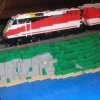Search the Community
Showing results for tags 'talgo'.
Found 3 results
-
Hi everyone, I present to you my second version of the Renfe S-130 like Ferro-Friki did some time ago. I wanted to remake this train that I made first in 2018 with not the best result so I now made this version in 7 studs. LEGO Renfe S-130 DEF [MOC] by Imanol, en Flickr The set is heavily detailed even in the rear of the power cars and end cars LEGO Renfe S-130 Testeros Interiores [MOC] by Imanol, en Flickr I have made a reduced train set of only 7 cars instead of the 11 that has in real life but it has one of each of the different cars that form the real train with detailed interiors. First the "Preferente" end and "Preferente" LEGO Renfe S-130 Lateral Extremo Preferente [MOC] by Imanol, en Flickr LEGO Renfe S-130 Lateral Preferente [MOC] by Imanol, en Flickr The interiors of "Preferente" cars LEGO Renfe S-130 Interior Preferente [MOC] by Imanol, en Flickr The "Preferente" adapted car and it´s interior LEGO Renfe S-130 Lateral Preferente PMR [MOC] by Imanol, en Flickr LEGO Renfe S-130 Interior Preferente PMR [MOC] by Imanol, en Flickr The cafe car and it´s interior LEGO Renfe S-130 Lateral Cafeteria [MOC] by Imanol, en Flickr LEGO Renfe S-130 Interior cafeteria [MOC] by Imanol, en Flickr And the Turista cars which are the same as preferente but with 2+2 seating arrangement LEGO Renfe S-130 Lateral Remolques Turista [MOC] by Imanol, en Flickr LEGO Renfe S-130 Lateral Remolques Turista [MOC] by Imanol, en Flickr And now that I presented it I want to ask for help to build it as it will be my first lego train in real life. The car coupling mechanism that I have installed is only for aesthetical purposes and will not work in real life. Another problem is that i have seen many models in which all of the rear of the locomotive or power car pivots and I don´t know if it could be necesary to do in this case. Lastly I want to know how to motorize it, being so long I would suppose I would need the two power cars to provide power but I don´t know. Anyway, I hope you enjoy this project as much as I enjoyed designing it
-
Hi everyone! This is my recreation of the Spanish high speed train Renfe AVE 102 and 112 series, manufactured and designed by the Spanish rolling-stock company Talgo (which they name Talgo 350). The train is nicknamed as "Pato", which literally translates to "Duck" due to its characteristic nose design, which resembles the one of a duck, apparently it highly reduces air noise. About the train, it was introduced into service in 2005 and is currently the star of the Spanish high speed network (soon to be joined by the new generation train Talgo Avril 106 series) with Renfe having 46 units of them, reaching speeds of 360 km/h with an operational speed of 330 km/h. Amazingly, the train weights very little for it's size and, as with every Talgo, it enables low-flow boarding meaning the door is at the height of the floor, without extra stairs needed inside to access the main cabin, making it very accessible thanks to the special single independent bogie design. As of the MOC, it's a minifigure scale recreation and 7 studs wide. The nose was quite a bit of a challenge, but I think the result was pretty accurate to the real thing. The characteristic bogie system by Talgo is quite hard to make in Lego, with the single wheel configuration, so I can't say the way it is on the model will work perfectly, but doesn't seem to have any issues. It is based off Ferro-Friki's version for the Renfe Talgo S130. Hopefully I can build it one day and test it out! Here some more close-up images of every part: (Ignore this last image, it won't delete)
-
Hello everyone! I've been lurking this forum for years now, occasionally posting in help topics. I have to admit, I'm not much of a train builder (hence my lack of posts), but I finally realized a dream I've had for a very long time. Amtrak Cascades by David Hensley, on Flickr It all started about 7 years ago.....I am a Seattle resident, and see this train passing by regularly. It's always held a special place for me. I always wanted to have a nice long train, but financial trouble made that hard, which is what got me into Talgo. I started off by building a copy of James Mathis's wonderful rendition of the Cascades, although mine was red for lack of parts. I continually improved on this design, making it more and more realistic. I must of went through at least 6 versions. 3 years ago, having no access to my bricks due to a move, I turned to LDD and decided to once again revisit the train. This time I decided to spare no detail, and upgrade to 7 wide. A year later, I finally gained access to my bricks, and tested the design, but money still kept me from building. 2 years, and a great career later, I finally decided it was time, and here is the result! NMRA_2015_30 by Allen Smith, on Flickr. Not my photo, taken at NMRA 2015 More photos with detailed descriptions on Flickr. The model is 7 wide, and powered by 4 L motors (2 per locomotive). She runs well, and will negotiate standard curves and switches. Now, since I'm here talking about trains, hopefully you won't mind if I dig up something from awhile back. Nordco Rail Inspection truck.



